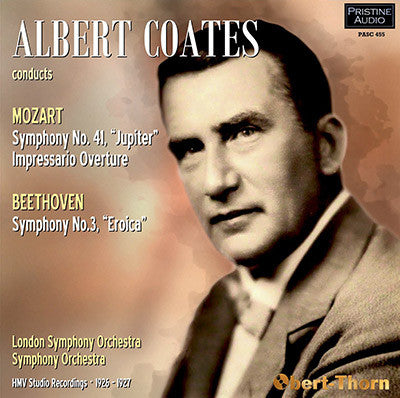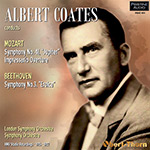
This album is included in the following sets:
This set contains the following albums:
- Producer's Note
- Full Track Listing
- Cover Art
Coates' astonishing 1920s Beethoven & Mozart
"Mozart’s
“Jupiter” Symphony begins with an Allegro vivace whose sheer blistering
speed beggars the imagination ... a heartening reminder of a kind of
interpretive individuality and courage that have all but vanished today"
- Fanfare
Conventional wisdom maintains that the Historically Informed Performance movement rescued Classical-era works from the stodginess of big orchestra performances. The present recordings are, perhaps, exceptions that prove the rule. No one could ever accuse Albert Coates (1882 - 1953) of being stodgy in any repertoire; but his tempi in the works of Mozart and Beethoven stand out particularly in the context of most other conductors of his era.
Coates had previously recorded Mozart’s Jupiter Symphony acoustically in 1923 (reissued on Pristine PASC 298), a performance whose tempos are, amazingly, even faster than the present electrical remake, although its running time is longer due to the inclusion there of the second movement repeat. The Impressario Overture was the filler side for both versions. Both the symphony and the overture were recorded at an August, 1927 session, incongruously separated by excerpts from Die Walküre and Götterdammerung for the “Potted Ring”, and the first movement was re-recorded at makeup session two months later. The fact that HMV chose Coates to do the electric remake suggests that both they and the public did not find his tempi to be unacceptably outrageous.
If the tempos of the Jupiter still seem a bit extreme, the Eroica would strike today’s sensibilities as perfectly acceptable, with crisp execution and an inevitable forward momentum. Coates had already recorded the Beethoven Seventh twice, both acoustically (PASC 298) and an unpublished early electric, and the Ninth had similarly been done in both acoustic and electric (PASC 296) versions. Clearly, HMV looked upon Coates as their “go-to” conductor for this repertoire. It is odd, over a year into electrical recording, to hear acoustic-style tuba reinforcement of the bass lines; yet, this practice was to continue even into the Kreisler/Blech Beethoven Violin Concerto, recorded in Berlin at the end of 1926.
A word is in order about the unnamed “Symphony Orchestra” heard in the Beethoven. At the time it was recorded, the London Symphony Orchestra was under contract to the rival Columbia label. Coates had been the principal conductor of the LSO from 1919 to 1922, and he continued to be closely associated with the ensemble. It is likely that the anonymous orchestra is in whole or greater part the LSO. By 1927, the orchestra was under exclusive contract to HMV, and is so credited for the Mozart recordings.
The quietest shellac sources were used for the present
transfers – the best sides from two copies each of prewar US Victor “Z”
pressings for the Mozart (album M-30) and a late prewar black label
Victor reissue (set G-2) of the Beethoven.
MOZART Symphony No. 41 in C major, K.551 ‘Jupiter’
London Symphony Orchestra
Recorded 26 August and 25 October 1927 in Queen’s Hall, London
Matrix nos. - CR 1476-3A, 1477-2, 1478-2A, 1479-2A, 1480-2A, 1481-1A and 1482-1A
First issued on HMV D 1359/62
MOZART The Impressario, K. 486 (Der Schauspieldirektor) - Overture
London Symphony Orchestra
Recorded 26 August 1927 in Queen’s Hall, London
Matrix nos. - CR 1488-1A
First issued on HMV D 1362
BEETHOVEN Symphony No. 3 in E flat major, Op. 55, ‘Eroica’
Symphony Orchestra
Recorded 16 September and 26 October 1926 in Kingsway Hall, London
Matrix nos. - CR 678-3A, 679-1, 680-2A, 681-1A, 682-1A, 683-1A, 684-3A, 685-1, 686-1, 687-1 and 688-1
First issued on HMV D 1158/63
Albert Coates, conductor
Fanfare Review
The LSO play with fire and conviction, while the spruced up 1926 Kingsway Hall recorded sound is the best we’re ever likely to hear
Born in Russia of English parents—as a boy, he once played for Tchaikovsky—Albert Coates studied with Rimsky-Korsakov in St. Petersburg (where his father was a successful businessman) and in Leipzig with Arthur Nikisch, who gave him his first job as répétiteur at the Leipzig Opera. By 1910, he had made his debut with the London Symphony, serving as its chief conductor from 1919 to 1922, after which he never again held a permanent post in Britain. Along with famously spoiling the world premiere of Elgar’s Cello Concerto by allotting the composer insufficient rehearsal time, he made some of the great recordings of the 78-rpm era, including the 1929 Frieda Leider/Lauritz Melchior recording of the Tristan love duet whose vocal opulence and sheer intensity have yet to be surpassed.
Coates’s 1926 recording of Mozart’s “Jupiter” Symphony begins with an Allegro vivace whose sheer blistering speed beggars the imagination, although incredibly enough the acoustical version from 1923 is even faster. (Coates was famous for unbuttoned tempos: Witness that breathlessly exhilarating version of Borodin’s Second Symphony.) The craziest thing is how convincing it becomes on repeated hearings, as shock gives way to dumbfounded amazement which yields open admiration. At very least, as producer Mark Obert-Thorn correctly points out, “Conventional wisdom maintains that the Historically Informed Performance movement rescued Classical-era works from the stodginess of big orchestra performances. The present recordings are, perhaps, exceptions that prove the rule.” While the elegantly shaped second movement and bouncing minuet are far more normal, the finale underscores the molto in the molto allegro mood indication, and—as in the opening movement—the conductor observes the exposition repeat. Although clearly at odds with today’s belligerent neo-Puritanism, this—and a genuinely mad, three-and-a-half minute Impresario Overture—is a heartening reminder of a kind of interpretive individuality and courage that have all but vanished today.
Tempos in the Coates “Eroica” are brisk but never break-neck, with a quarter-hour funeral march that tugs at the heart-strings in a direct and very moving way. The oozing string slides that were Mengelberg’s signature in Beethoven (and elsewhere) are almost entirely absent, and what rubato creeps in is applied in a uniformly tasteful manner. Apart from a scherzo that clocks in at under four minutes—a combination of a snappy tempo and no repeats—the outer movements sound surprisingly modern, with a bracing sense of inevitability in the most famous of all Allegro con brios and a sequence of variations which—as in all great performances—add up to considerably more than the sum of their richly various parts. The LSO—as the “Symphony Orchestra” on the labels almost certainly was—play with fire and conviction, while the spruced up 1926 Kingsway Hall recorded sound is the best we’re ever likely to hear.
Jim Svejda
This article originally appeared in Issue 40:1 (Sept/Oct 2016) of Fanfare Magazine.

